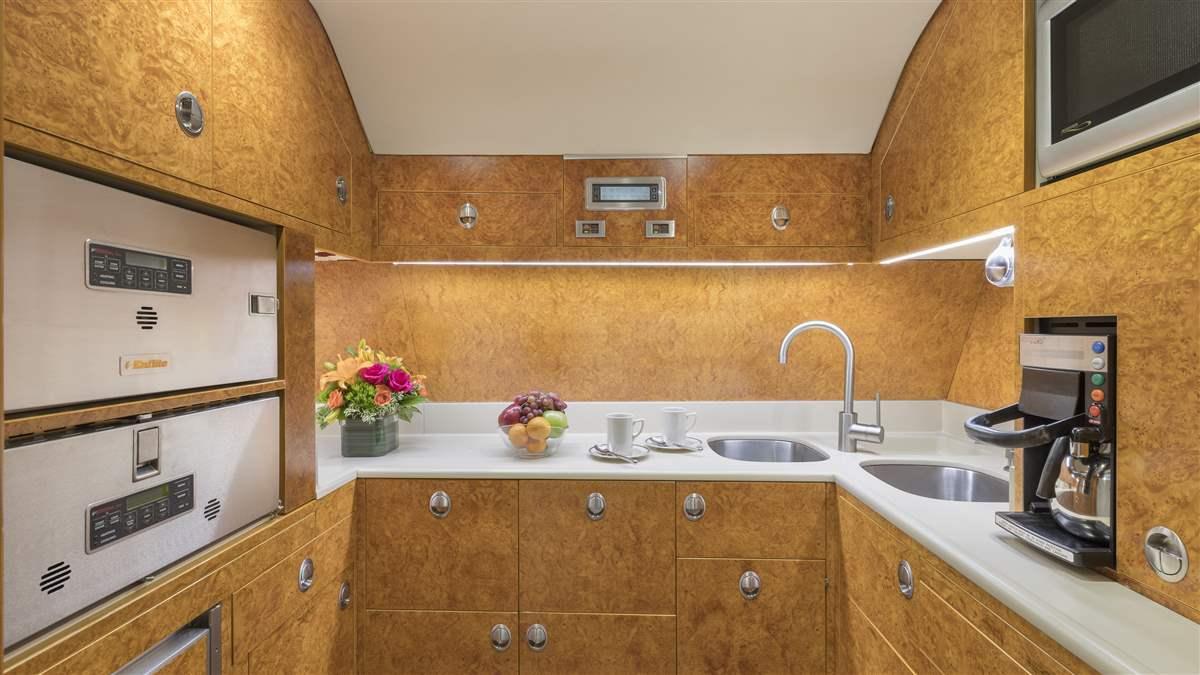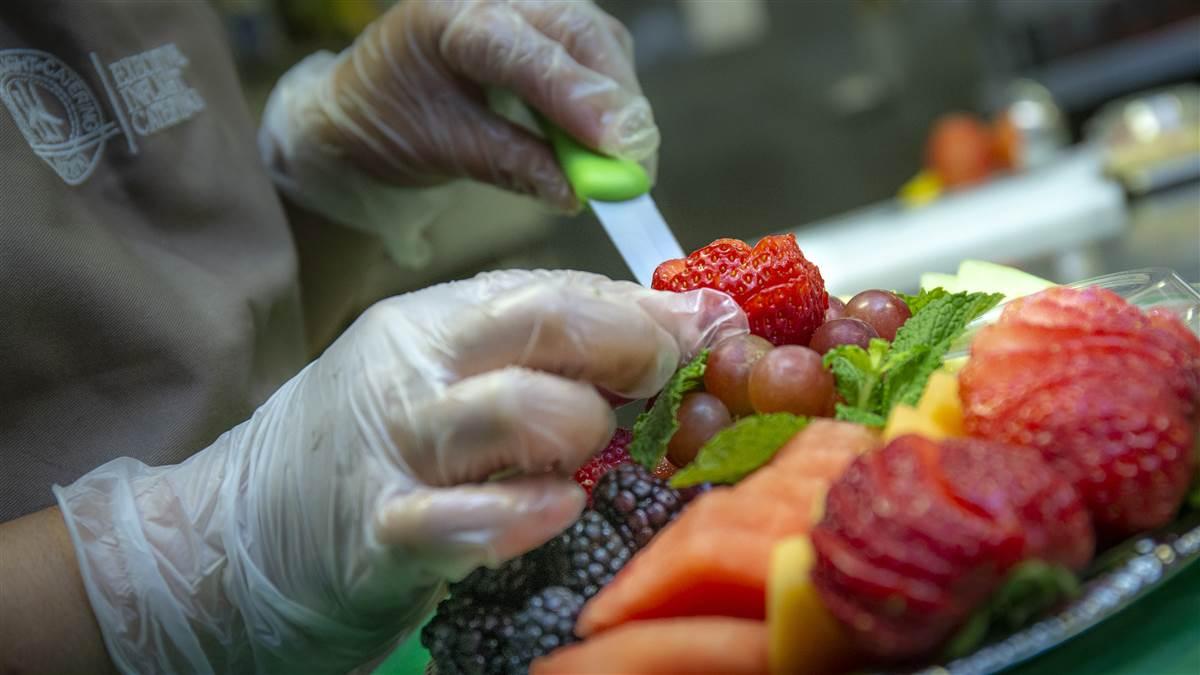Upscale on top
When you want to spice things up

 The galley in the aft cabin area of this corporate Boeing BBJ has two convection ovens and a refrigerator on the left side, running water, and a microwave oven on the right side.
The galley in the aft cabin area of this corporate Boeing BBJ has two convection ovens and a refrigerator on the left side, running water, and a microwave oven on the right side.Photo by Chad Slattery
 The galley of this Gulfstream IV, just aft of the cockpit, has less in the way of ovens, but plenty of open storage area up top. Still, it has plenty of work surfaces, a warming oven, two sinks, running water, and is perfect for storing and reheating already-prepared food. The glassware ain’t bad, either.
The galley of this Gulfstream IV, just aft of the cockpit, has less in the way of ovens, but plenty of open storage area up top. Still, it has plenty of work surfaces, a warming oven, two sinks, running water, and is perfect for storing and reheating already-prepared food. The glassware ain’t bad, either.Photo by Chad Slattery
Not only do aircraft owners like fresh food, they want it to reflect modern culinary trends and quality. To accomplish that, increasing numbers of business aircraft flight attendants are taking culinary lessons to elevate their level of service. Sometimes it’s a chef who climbs onboard, especially on private Boeing and Airbus aircraft. Often that chef is also trained as a flight attendant.
“We’ve got seven or eight airplanes we send chefs on, four or five times a year,” said Daniel Hulme, owner of On Air Dining in London. “The Four Seasons Boeing 757 has two onboard chefs but they order all the food from us.”
“Owners are always demanding higher-quality food, whether it is fine dining or home-style food or a sandwich tray. In general, catering isn’t great. That’s why my company has grown so quickly. I do everything from a 747 to a [Cessna] Citation,” Hulme added.
To keep up with the demand, flight-attendant training schools have added courses on plating, menu preparation, molecular gastronomy, and food preparation. New schools specializing in upgraded skills and service have sprung up—such as DaVinci Inflight Training Institute in Fort Lauderdale, Florida, founded by Paula Kraft, who owns the catering company Tastefully Yours in Atlanta. Hulme is one of her instructors. At the school, instructors from all over the world gather to teach the care and handling not just of billionaires, but corporation chiefs and heads of state. There is even a class on butler skills.
“It has helped caterer sales,” Kraft said. “Rather than pack a full meal in a cooler container to be reheated, a fillet is spiced and left uncooked to be cooked onboard.”
DaVinci follows by several years the first school to teach culinary skills—the Corporate School of Etiquette in Long Beach, California. Founder of the school, Donna Casacchia, said she also provided classes in 2017 at Scott Air Force Base, MacDill Air Force Base, and Joint Base Andrews—home base to Air Force One. Classes have included Air Force One crews. Kraft also utilizes a former Air Force One flight attendant supervisor as one of her instructors.
To make sure attendants understand their customer’s expectations, Casacchia offers a class at the Montage Laguna Beach resort in California where they are served a five-star meal and briefed on its preparation and presentation.
“[Crew] on long-range aircraft need to know how to prepare meals. You’re on the airplane a long time,” Casacchia said.
Even if the finest meal ever made is presented onboard, the passengers may not be able to taste it as well in the 8,000-foot pressurized cabin. “Your taste buds are massively affected by the pressure,” said Hulme. “Also, it is an extremely dry environment. You lose about 50 percent of the taste of salt.”
 “When you are flying you lose 20 percent of your perception of food. We spice up everything differently,” said Pierre Rambroul, owner of Uppersky Gourmet at Le Bourget Airport in Paris. Like Hulme, he is a DaVinci instructor. The pressure’s on since passengers realize they are in a country—France—with a reputation for fine food. “The passengers like sandwiches but we make typical French dishes as well,” he said. “Quiche Lorraine. We cook just enough so that reheating finishes the dish.”
“When you are flying you lose 20 percent of your perception of food. We spice up everything differently,” said Pierre Rambroul, owner of Uppersky Gourmet at Le Bourget Airport in Paris. Like Hulme, he is a DaVinci instructor. The pressure’s on since passengers realize they are in a country—France—with a reputation for fine food. “The passengers like sandwiches but we make typical French dishes as well,” he said. “Quiche Lorraine. We cook just enough so that reheating finishes the dish.”
“Soufflé is a tricky one because of expansion and bubbles,” Rambroul added. “We use other products that give the same effect as a soufflé or a mousse.”
Potatoes have to be started in the microwave and then finished in an onboard convection oven to make them crispy. Otherwise, in the higher-altitude cabin, they would take two hours.
To prepare that fancy meal you need better equipment than found on early corporate aircraft. Casacchia pioneered the use of induction cooktops and consulted with airlines and corporate jet manufacturers to bring them into wider use. An induction cooktop is a plug-in countertop appliance that will heat the sauce but won’t set paper towels on fire or burn your hand—the heat dissipates once the pan leaves the surface.
The source for food is typically the grocery store. “Once in a blue moon we will use a caterer because we fly all over the world,” said Scott Arnold, a partner in DaVinci and a crew member for a private jet. “But it’s very rare. Most of it is just grocery stores and that’s it. We make everything from scratch.”
That’s how Sara Culver-Truby does it. She is a lead flight attendant at Y2K Aviation in Hillsboro, Oregon, an instructor at DaVinci, and was a caterer for 20 years. “There are times when they [clients] want to keep it casual but there are times when they want to pick it up. They want a silver service with caviar and seven courses.”
“I prepare most of the courses myself. I have the culinary background. I do utilize caterers, restaurants, and hotels, when I need to due to time limitations. I will reheat or I will have them prep it out for me and then I will heat it up for the first time.
“You gotta be creative. You have to learn to cook in a small space. I grew up on an old wooden sailing schooner. My mother used to prepare everything onboard,” Culver-Truby recalled.
Those thinking about a flight attendant career in the corporate world might first make a stop at a culinary school, if you want to class it up, up there.



